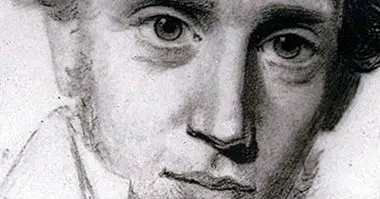Lasswell model: the elements of communication
The Laswell model is a construct that has allowed to study mass communication , as well as its components and effects in different audiences. Initially, the model was intended to be offered as a tool to classify studies in mass communication, as well as to analyze the variables that determine the transmission of a message. However, this model has generated a series of very useful concepts to analyze communicative acts in general, beyond mass communication.
In this article we will see what is the Laswell model , how it came about and what are some of its main elements.
- Related article: "The 28 types of communication and their characteristics"
The Lasswell model: what is communication?
In the 1940s, the American sociologist Harold Lasswell developed a model that allowed to understand the communicative process in a way that was innovative for the first half of the 20th century.
Very roughly analyzed the channels through which the communication occurs, and realizes that the transmission of any message flows through different devices, since are immersed in a plural society with multiple audiences .
In addition, he notes that, although mass communication occurred unidirectionally in most channels; audiences can also have an active role in the process , which implies that it is possible to close the communicative cycles that seem to be unilateral.
When Lasswell studied the messages exchanged in the different communication channels, he asked himself "Who said what, in what channel, to whom, and with what effect?", "Who gets what and how?".
- Maybe you're interested: "Active listening: the key to communicating with others"
Beginnings and history
Although he did not patent it or claim it as his own, the model got its name after it became popular in 1948, following the publication of an article entitled "The structure and function of communication in society". For the same reason, it is often thought that this text founded the model. In fact, Laswell is considered one of the fathers of political psychology and, among other things, helped to consolidate the studies of mass communication, as well as its dissemination.
However, the publications that preceded it are those that really allowed to lay its foundations. Likewise, there are different opinions about who or who were the ones who developed this model. For example, some authors attribute it to John Marshall ; other authors attribute it to both Lasswell and Marshall.
In any case, both at a theoretical and methodological level, this model significantly impacted different disciplines: communication studies, political science, communication, law, philosophy, psychology, economics, anthropology. Specifically, it was possible to consolidate the objective of research in mass communication, which is to determine who and with what intentions has said what, to whom, and with what effects.
The elements and the communication process
One of the contextual elements around which this model is popularized is the intention of reduce communication gaps between civil society and government . This could be possible through an alternative channel that not only served to inform unilaterally, but was useful to establish communication reciprocally.
But, what were the channels of communication available? Impressions, movies, television, radio. In short, channels that establish unilateral communication, with what were not closed cycles. The idea arises then that a new one can be promoted: academic research; that could serve as a medium or a communicative platform for society.
During the Second World War, Laswell participated in a communication project in which he was in charge of studying Hitler's speeches in relation to his audience. This study was done paying attention both verbal and non-verbal communication elements , following the line of questions of what, who, how, and with what effect.
For the first time the audience had an active role in the analysis of the communicative process: through their studies, the discourse began to be seen not as a monologue, but as an act where listeners they also produce an effect in the same speech .
According to Lasswell, mass communication not only aims to faithfully and objectively convey a fact, but goes further. Among its purposes is:
- Report on the most recent global and local events.
- Interpret these events through a specific ideology.
- Impact on the interpretation of the world of the spectators.
Components of communication and levels of analysis
In the area of mass communication, it is common for phenomena to be analyzed based on a series of questions that refer to different levels of analysis with communicative components for one; and that they arose precisely from the Laswell model. In addition, from these, Laswell stated that every communication process has different elements: emitter, content, channel, receiver, effect .
1. Content analysis (what?)
The content analysis corresponds to the communicative component of the content or message. It is about the communicative stimuli that arise from the person issuing the message .
2. Control analysis (who?)
The level of control analysis corresponds to the communicative component "who?". In other words, it is the sender: the person who generates a message or communicative stimulus, and who expects a response from the recipient.
3. Analysis of the medium (how?)
The communicative component "how?" Can be analyzed from the middle or channel, through which the message is transmitted . It is the way in which the content travels from sender to receiver.
4. Analysis of the audience (to whom?)
The analysis dimension of the audience allows answering the question about who is the receiver; that is, the person who is expected to receive the sender's message . This question and dimension of analysis are fundamental in the studies on mass communication, since both the message and the channel depend to a large extent on how the receiver is.
5. Analysis of the effects (for what?)
In the analysis of the effects or the results of the communication, it is investigated by means of the question ¿why? It is about analyzing whether the objectives of transmitting a certain message have been fulfilled or not; and if not, then the effect that such transmission has created is studied. For Lasswell, all communication has an effect, whether or not it was originally planned , and that is what determines the structure of mass communication.
Bibliographic references:
- Rodríguez, A. (2018) Lasswell model: what it consists of, elements, advantages and disadvantages. Retrieved July 24, 2018. Available at //www.lifeder.com/modelo-lasswell/.
- Sapienza, Z., Iyer, N. & Veenstra, A. (2015). Reading Lasswell's Model of Communication Backward: Three Scholarly Misconceptions. Mass Communication and Society, 18: 5, 559-622.
- Narula, U. (2006). Communication Models Atlantic: India.



















